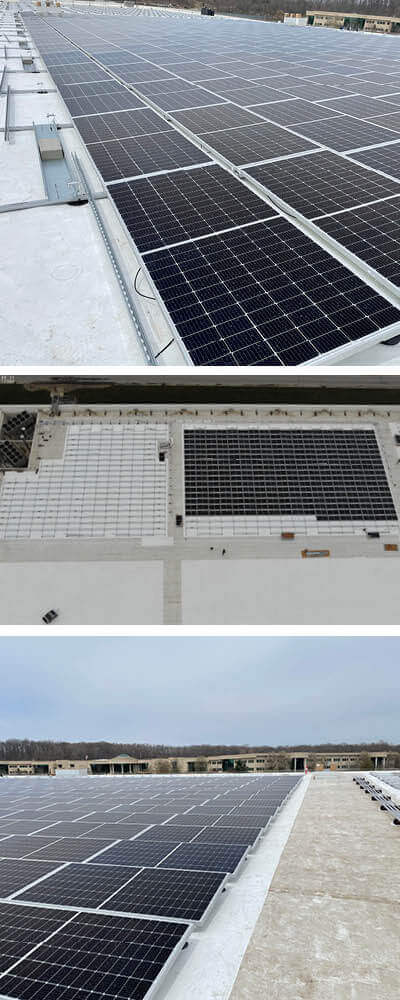Solar arrays brighten a sustainable future at Cook’s headquarters
They traveled by steam ship and by semi-trailer truck across the globe to settle in Bloomington, Indiana. The journey began in Kolkata, India. Over 3,000 solar panels were carefully bundled in crates and loaded onto a steam ship to be transported to Norfolk, Virginia. The shipment went through customs in Norfolk, and the crates were unloaded and packed into a truck for the final leg of the trip to Bloomington. Almost a month after the start of the voyage, the solar panels arrived in Bloomington, Indiana at Cook Medical’s headquarters to be installed at Cook’s American Distribution Center and at headquarters.
Why solar panels?
“Solar panels are a source of renewable energy that demonstrate Cook’s commitment to sustainability,” explained Drew Northern, Vice President and Chief Ethics & Compliance Officer of Cook Group.
The term “carbon footprint” refers to the amount of greenhouse gases that a person or group produces in the course of operations. By installing solar arrays, Cook will reduce its carbon footprint and turn unused rooftops into a source of clean energy for the facility. When using renewable energy, like solar or wind, energy comes from the sun or natural processes that regenerate naturally. Traditional energy production burns fuel and generates pollution. So, the less traditional energy we use in our operations, the better our carbon footprint will be, and the renewable energy helps to improve our environmental performance.
For Cook’s American Distribution Center, the solar panels will eventually offset energy almost 50% of the site’s energy costs, and for Cook Medical’s headquarters, the total energy bill will be offset by 15% to 20%. The cost of installing the solar panels is a hard project cost, but the return on investment (ROI), the amount of time it takes those savings to equal the cost of the project, is typically within five to ten years.
“The installation of solar panels at the AMER Distribution Center is an opportunity to reduce energy costs while promoting sustainability,” Drew said, “Indiana is a state where renewable energy makes financial and environmental sense.”
Going solar makes a difference 
- Cook Medical’s headquarters and Cook’s American Distribution Center ‘s solar arrays will offset more than 1,000 metric tons of CO2 in the first year alone. That is equal to the amount of CO2 generated from burning 6 rail cars worth of coal, and that is only from the first year of energy production.
- At Cook’s American Distribution Center, the one-year carbon offset is equivalent to 1,335,800 miles driven by a passenger car.
- At Cook Medical’s headquarters, the one-year carbon offset is equivalent to the electric usage in 107 homes for one year.
The planning process
During the planning process for the solar installation, there were some nuances for such a large environmental project for the Cook headquarters.
Both facilities gain direct power from the solar panels and no battery pack for storing energy will be used. When the sun’s not out, the panels will not be gathering power, but when the sun is out, the power is there. Indiana public utilities offer 1:1 net metering for solar projects. This means that if there is ever a time that the solar arrays produce more energy than the owner uses, then that energy will flow to the grid, and the owner will be credited for the energy at the same rate they pay for energy. At times when the solar arrays are not producing as much energy as needed, energy will be drawn from the grid.
“Solar energy reduces carbon emissions, water use, and water pollution contributing to environmental sustainability,” said Drew.
Sustainability facts about Cook around the globe
International Standards of Operations, or ISO standards, are designed to set up requirements that demonstrate core competencies in a variety of subjects related to manufacturing products, services and systems. For example, a company can achieve ISO 14001 certification of their environmental management system’s ability to minimize negative environmental impact. The following Cook entities have become ISO 14001 certified in the area of sustainability:
Cook Limerick—Achieved ISO 14001 and ISO 50001 (requirements for energy efficiency) Certifications in 2019.
Cook Denmark, WCE—Achieved ISO 14001 Certification in March 2020.
Cook Winston-Salem— Achieved ISO 14001 Certification in February 2022. Here are some of the objectives they will continue working toward:
- Energy Management: Reduce energy consumption by 10% by 2027.
- Environmental Assurance: Assess environmental compliance assurance.
- Solid Waste: Establish baseline and optimize waste management system by 2024.
- Recycling: Increase recycling of metals, plastics, and cardboard by 5% by 2023.
Also, Cook Australia, WCA—Was the first Cook Medical manufacturing site to use solar power to supplement energy use in 2015.
